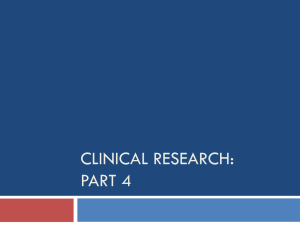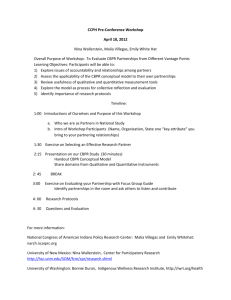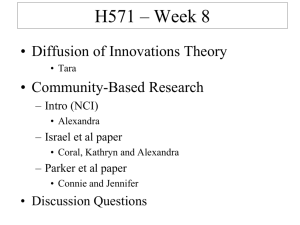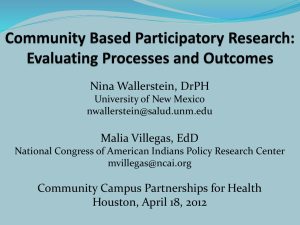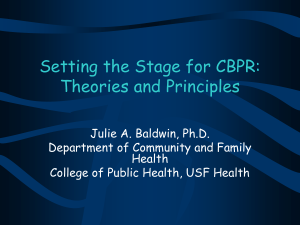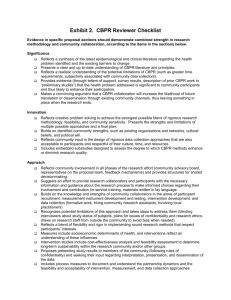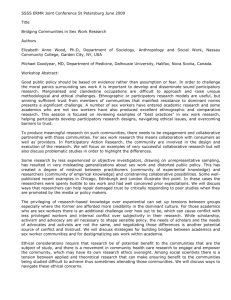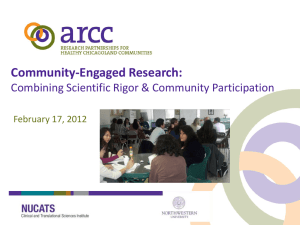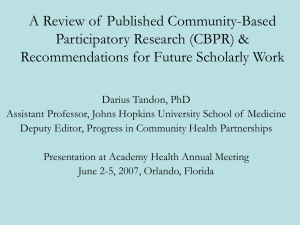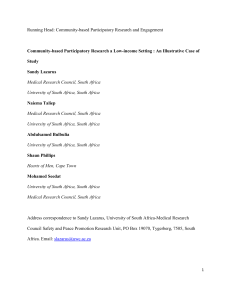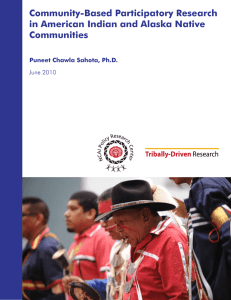Research - University of Colorado Denver
advertisement
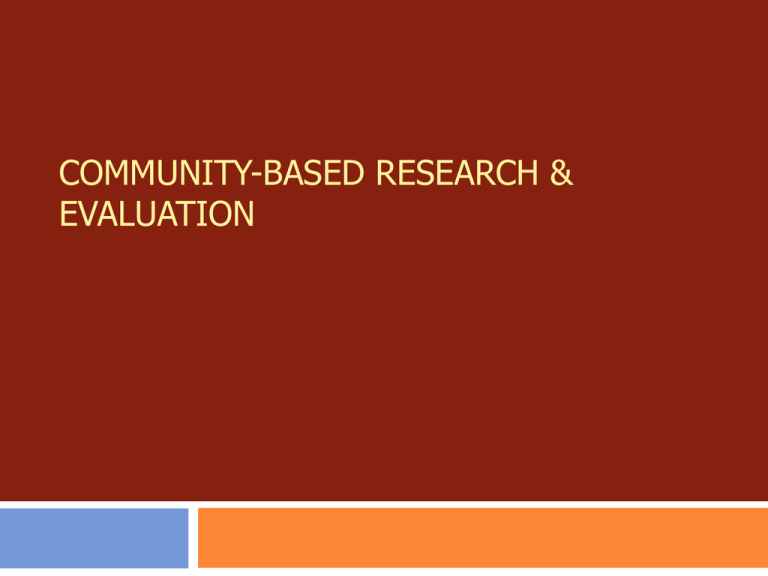
COMMUNITY-BASED RESEARCH & EVALUATION Primary Authors: Jessica V. Barnes-Najor Ann Belleau Rick Burnett Contributing Authors: Robert Brown Patricia Farrell Millie Horodynski Miles McNall Anne Suggitt Mavany Verdugo “a more democratic and ecological approach to scientific study is necessary” Wing, 1998, p. 250 Defining the CBPR Elements Section 1. Definitions Major Terms Research: “the systematic process of collecting and analyzing information (data) in order to increase our understanding of the phenomenon with which we are concerned or interested” (Leedy, 1996, p. 3) http://www.memphis.edu/crow/ • Evaluation: “the use of social research methods to systematically investigate the effectiveness of social intervention programs…” [emphasis mine] (Rossi, Freeman & Lipsey, 1999, p. 20) http://meds.queensu.ca/postgraduate/policies/evaluation Major Terms Community-based research & evaluation: research and evaluation done in communities, with minimal participation of community members Community-based participatory research & evaluation: research and evaluation done with communities, involving community members in the research process Tribal Participatory Research Collaborative research designed to meet the needs of tribal communities and avoid or minimize issues of exploitation and power disparities Emphasis is on social change and community empowerment using psychosocial interventions designed to reduce behavioral health disparities and to support healthy development Mechanisms of TPR Tribal oversight Use of a facilitator Training of community members as project staff Use of culturally specific assessment and intervention methods Activity 1 CBPR Research POLL: Have you participated in CBPR research before? Yes, as a community partner Yes, as a research partner No Not sure Community-based Participatory Research From researchers acting upon a community to answer a research question to researchers working side by side with community members to define the questions and methods, implement the research, disseminate the findings and apply them An approach, not a method! (The Examining Community-Institutional Partnerships for Prevention Research Group, 2006) Understanding “Participatory” in CBPR “Participatory research is fundamentally about who has the right to speak, to analyze and to act” (Hall, 1992 p. 22) “the attitudes of researchers, which in turn determine how, by and for whom research is conceptualized and conducted” (Cornwall and Jewkes, 1995, p. 1667) Key Principles of CBPR 1. Recognizes community as a unit of identity 2. Builds on strengths and resources within the community 3. Facilitates collaborative partnerships in all phases of the research 4. Integrates Knowledge and action for mutual benefit of all partners 5.Promotes co-learning and empowering process that attends to social inequalities 6. Involves a cyclical and iterative process 7. Disseminates findings and knowledge gained to all partners A collaborative inquiry approach with roots in both the northern and southern traditions SECTION 2. COMMUNITY-BASED PARTICIPATORY RESEARCH Reasons for CBPR: Ethical Considerations Community members are asking for research to address their locally identified needs “drive-by data collection” Promotes co-learning: Findings can be used by the community to develop its own solutions to its problems Collaborative research promotes trust between researchers and communities (changes in power relationships) Source: The Examining Community-Institutional Partnerships for Reasons for CBPR: Research Quality Social, political, and economic systems play a role in the development of complex social problems Community involvement can enhance the quality of research Source: The Examining Community-Institutional Partnerships for Guiding Principles: Community Recognizes community as a unit of identity with shared fate May be based on geographic communities, virtual communities, communities of circumstance Builds on strengths and resources within the community Strengths and resources: knowledge, skills, and assets of individuals, social capital, and mediating structures Source: Minkler & Wallerstein, 2001 Guiding Principles: Collegiate Facilitates collaborative, equitable partnership in all phases of the research Collaborative: all parties participate and share control over the process Equitable: acknowledges and attends to inequalities between researchers and community members while creating an empowering process that involves shared power and resources Guiding Principles: Addressing Inequities The participatory approach facilitates an understanding of: Each individual’s position, unique needs, and contributions Local knowledge Equity of community partners, community partners & researchers, researchers Understanding of cultural differences and experiences of inequities Mutual benefit to all partners Guiding Principles: Systemic Focus on the “big picture”: Cyclical and iterative process Addressing multiple domains Involving multiple sectors/disciplines Key Issues In Participatory Research Projects Identifying collaborators Levels of participation Competing priorities Key Issues in CBPR: “Community Collaborators” Who is the “community” in CBPR partnerships? Communities in CBPR partnerships are often “represented” by the leaders of local community-based organizations So, whose interests are represented? The organization’s or the community’s? How well can leaders of local CBOs, who are often better educated and (relatively) more affluent than the average community resident, represent local residents? Collaborators Potential community collaborators Professional staff employed by local agencies/organizations who provide services Managers or supervisors of local agencies/organizations Clients of local agencies/organizations Citizens of the community Potential researcher collaborators Tribal research administrators Faculty Research staff Graduate students Undergraduate students Key issues in CBPR: Competing Priorities Academic priorities Community priorities Key issues in CBPR: Levels of Participation Three dimensions of participation in collaborative inquiry: Selection for participation Control of decision making Depth of participation Source: Cousin’s and Whitmore’s (1998) Basic Methods of Participation Contractual: Researchers contract for services (e.g., interviewing, data collection) or resources (e.g., time or property) from community members Consultative: Community members are asked for their opinions and advice before the intervention is designed Collaborative: Researchers and community members work together on a study that is designed, initiative and managed by researchers Collegiate: Researchers and community members work together as colleagues, each with skills to offer for mutual learning Challenges of CBPR Allocation of time & funding: involves longterm commitment Defining community Building and maintaining trust CHALLENGES AHEAD Understanding and addressing differences between community and academic perspectives and needs Distinct Phases Mark the Process of Conducting CBPR SECTION 3. CONDUCTING CBPR CBPR Phases Phase I: Partnership Development Phase II: Project Development Phase III: Project Implementation Phase IV: Data Analysis & Interpretation Phase V: Product Generation PHASE I: Partnership Development Step 1: Establish a community advisory group Step 2: Define roles Step 3: Develop contract or MOU PHASE II: Project Development Step 4: Get to know the issues Step 5: Develop the methodology Step 6: Review the MOU and the Research Plan PHASE III: Project Implementation Step 7: Implement the project (deliver intervention and collect data) PHASE IV: Data Analysis and Interpretation Step 8: Analyze the data Step 9: Meet with partners to review findings PHASE V: Product Generation Step 10: Prepare written reports Step 11: Conduct presentations of the findings Step 12: Prepare scholarly reports Degree of Collaborative Processes in Engaged Research Stanton, T. K. (2008). New times demand new scholarship : Opportunities and challenges for civic engagement at research universities. Education, Citizenship and Social Justice, 3(19), 19–42. doi:10.1177/1746197907086716 Activity Poll In your experience, who had more control in the research process? Research partners were in greater control Community partners were in more control There were equal amounts of control I have never been involved in a research partnership between community and university University Outreach and Engagement Michigan State University Kellogg Center, Garden Level East Lansing, MI 48824-1022 Phone: (517) 353-8977 Fax: (517) 432-9541 E-mail: outreach@msu.edu Web site: outreach.msu.edu CONTACT INFORMATION
